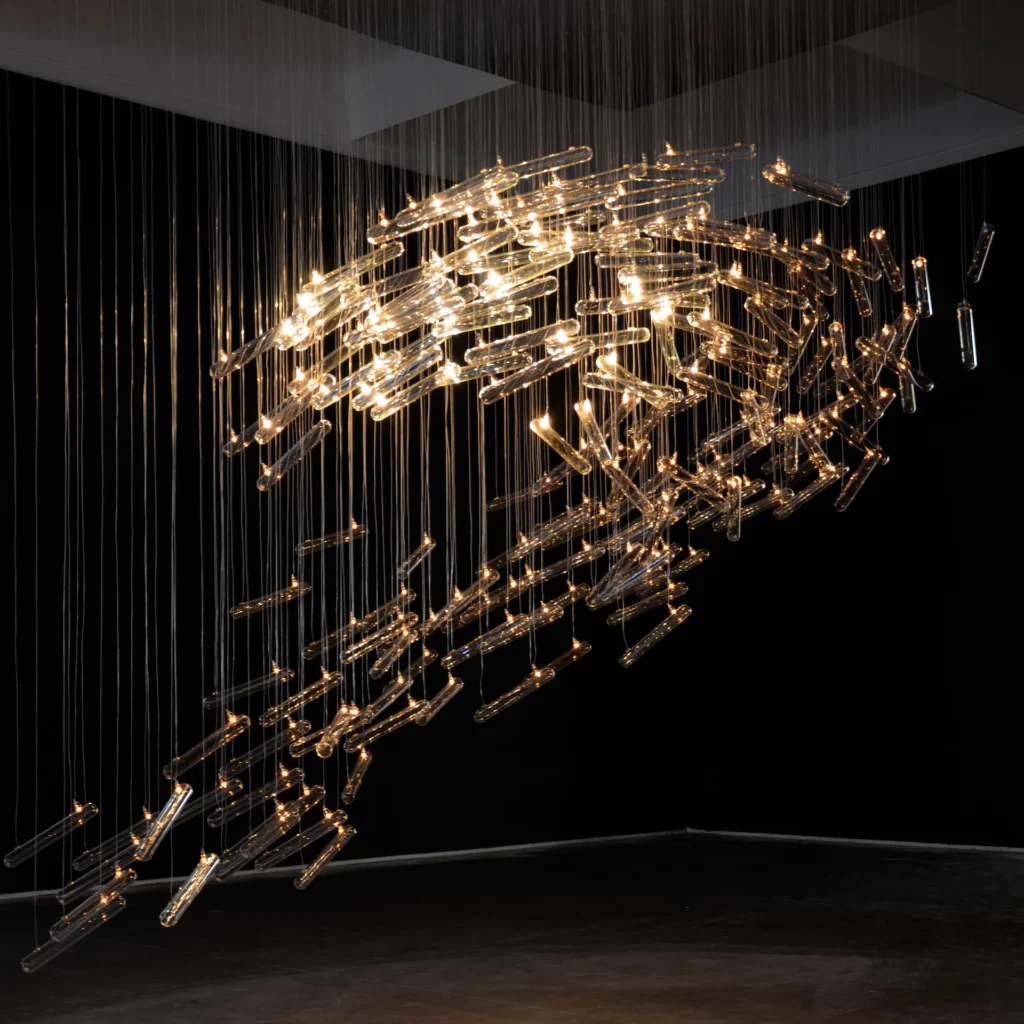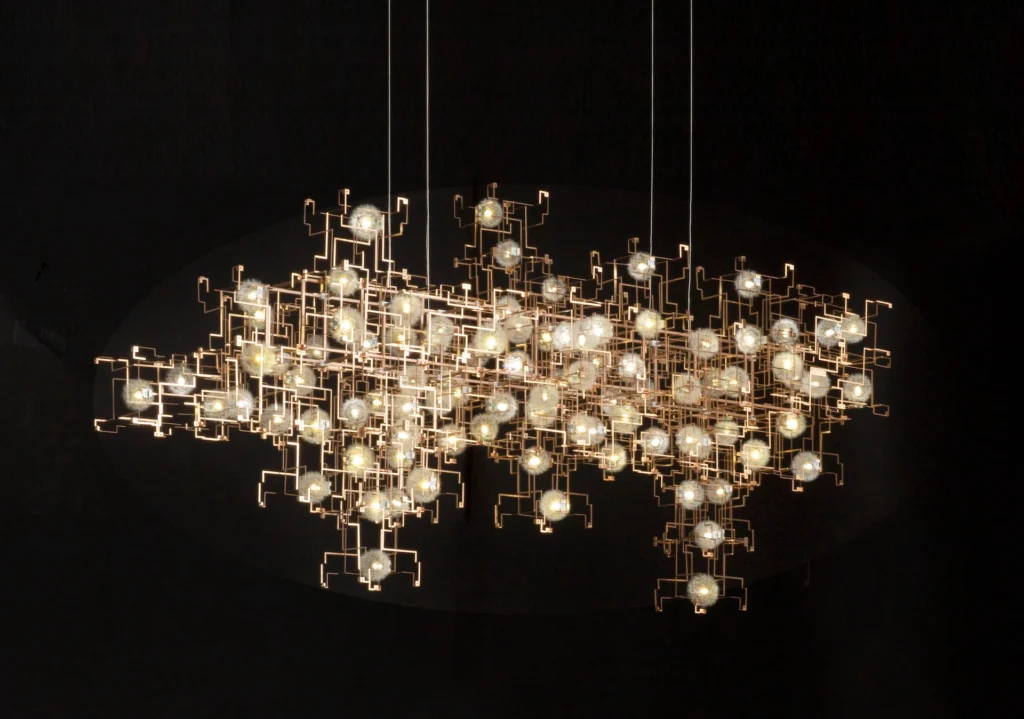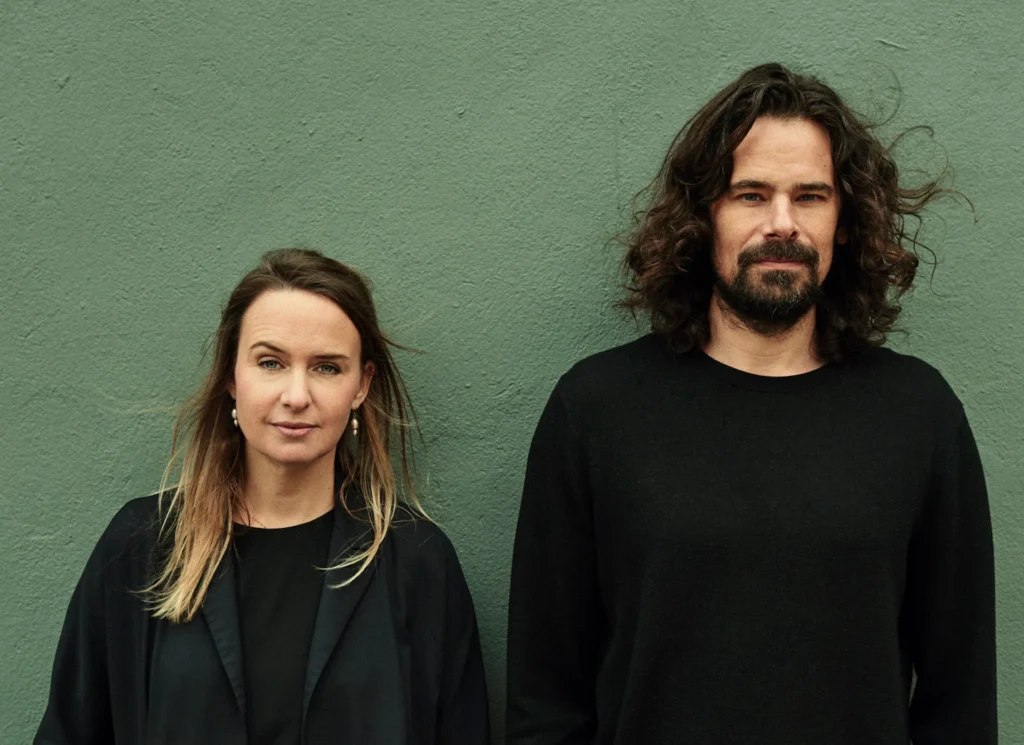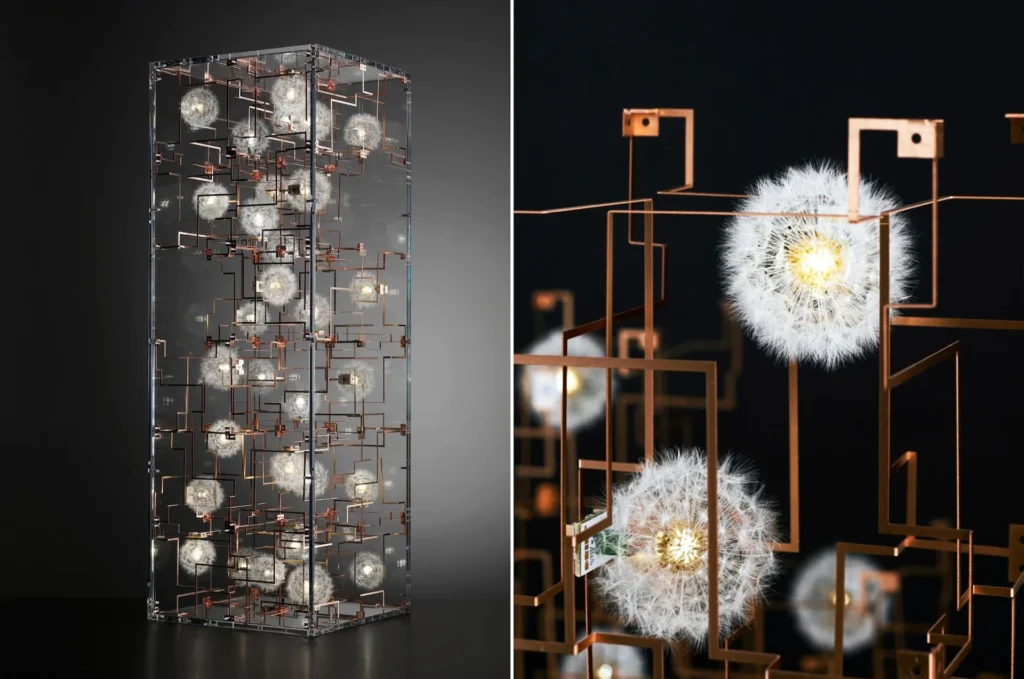
“DRIFT’s first public installation of Shylight (2015) added an unexpected element of surprise to a formerly hidden part in the Rijksmuseum. Commissioned as part of the institution’s years-long overhaul, DRIFT’s design offers exactly what every museum visitor should experience: wonder and exploration.”
—Wim Pijbes, Emeritus General Director of the Rijksmuseum in Amsterdam
It’s no surprise that, when asked to comment on DRIFT’s Shylight installation in the Philips Wing of the Rijksmuseum, Emeritus Director Wim Pijbes highlighted the experiential qualities. Wherever DRIFT has presented incarnations of these poetic, kinetic sculptures—from the Chodov Centre in Prague in 2016 and Design Miami/ Basel in 2021, to the New York City Ballet last month—audiences have been rapt, staring up in wonder and delight as the illuminated, flower-like elements dance with passersby in sync with natural algorithms.
The Shylight series is just one among many that exemplifies the Amsterdam-based studio’s singular talent for merging nature, technology, and performance to create objects and spaces suffused with visual fascination and emotional poignancy. During our recent Materials and Furniture: The Legends conversation, Ralph Nauta, who cofounded DRIFT with Lonneke Gordijn in 2007, reflected on his studio’s creative path, offering insights into how the duo become one of today’s most in-demand practices and success stories at the intersection of art and design.
With major-league representation by Pace Gallery and Carpenters Workshop Gallery fueling a steady flow of commissions from cultural institutions and private collectors around the world, DRIFT’s success is at an all-time high—and there’s no slowdown in sight. The studio’s beginnings though, Nauta told us, were much less glamorous. To achieve their vision over the last decade and half, Gordijn and Nauta had to be unwaveringly courageous and determined, refusing to compromise their commitment to experimentation, invention, and environmentalism, even when opportunities were harder to find.
The duo built their practice on a strong foundation by attending the Design Academy Eindhoven in the mid-2000s, when the legendary Lidewii Edelkoort was at the helm, shaping the school into the world’s most influential contemporary design incubator. Nauta told us that, after an initial visit to Design Academy Eindhoven, he knew this is where he had to go, because it “embraced ideas, encouraged experimentation, and urged new thinking.” Lonneke, he added, was the first person he met on the first day of school—as if they were destined for each other. Nauta was immediately drawn to “her energy, beauty, and out-of-the-box concepts” and knew he wanted her in his life. Looking back on his formative time at the academy, Nauta said there was no better place to develop creatively, and he would be a different person without that experience.
Fragile Future, DRIFT’s most recognizable design, began as the duo’s Design Academy Eindhoven graduation project and continues to encapsulate their shared mission. Composed of dried dandelion seeds adhered by hand to LED bulbs, these modular light sculptures are produced through a labor-intensive process and serve as a metaphor for the fragile future of our planet. Like much of the studio’s work, Fragile Future envisions a way forward by championing a symbiosis—a co-evolution—between nature and technology.
In its first iteration, Fragile Future featured a single “light emitting dandelion” attached directly to its power source, a 9-volt battery. The concept has since grown exponentially, thanks to Carpenters Workshop Gallery’s founders Julien Lombrail and Loic Le Gaillard, who recognized that the sensational yet simple form could be infinitely multiplied when coupled with three-dimensional bronze electrical circuits. Fragile Future has become DRIFT’s most commercially successful design, available across a range of scales, customizable to suit diverse functions and architectural settings.
As demand for Fragile Future light sculptures has grown, the studio began to approach the annual dandelion harvest as a ceremonial ritual. Every spring—after the flowers have turned to seed but before the white fluff is scattered in the wind—the entire studio, currently around 75 people, participates in a “harvest picnic” to celebrate the weed that set DRIFT on its upward trajectory. The 15,000 seeds they reap serve the studio’s production for the year.
Those who frequent Milan Design Week likely remember DRIFT’s debut at the world’s most important design event and the launch of the duo’s Ghost collection at the Hotel Nhow Milano in 2008. Like Fragile Future, these rigid acrylic chairs juxtapose the hard and the soft, as gossamer organic forms float within the transparent, rectilinear silhouettes. The message underlying DRIFT’s Ghost collection was clear: technology has freed design from the constraints of the past.
The Ghost collection was well received at the time and can now be found in major collections like the San Francisco Museum of Art. But Nauta shared the intense effort that went into that unforgettable unveiling in Milan. Gordijn and Nauta had driven their work to Milan from Amsterdam themselves and, lacking funds for a hotel, spent the week sleeping in a freezing tent.
As DRIFT increasingly creates works that are ostensibly non-functional, Nauta told us that ruminations over the boundaries between art and design are ever-present in his mind. He noted that innovative material explorations and close connections with new technologies drive his studio as well as the contemporary design conversation at large, but they are largely absent from the art world. Given DRIFT’s representation by both an art and design gallery, he said, the difference between the two arenas is mostly an illusion—except the way collectors respond. It is harder, he added, to educate and convert collectors to the design market, which is in many ways still in its infancy.
DRIFT’s monument kinetic installation at The Shed art center in NYC in 2021 was initiated by Pace Gallery and was aimed at the general public beyond art world collectors. Featuring an immersive environment of sound, movement, and film, DRIFT: Fragile Future, as it was titled, invited audiences on a journey to connect with our planet, its natural processes, and each other. The project offered a communal experience to be shared and little for collectors to acquire personally.
I asked Kimberly Jones, Senior Director at Pace, what aspects of DRIFT’s work most align with the gallery’s program. She told me, “Through their artistic practice, DRIFT explores the relationships between nature, technology, and humanity. Like all great art, they address fundamental questions about life and society’s place in the universe.” She added, “Their experiential sculpture, interactive displays, installations, and performances are a perfect fit for Pace, given the gallery’s history of championing innovative, technologically engaged artists.”
How will DRIFT’s work be viewed by history, given its striking resonance with the now? What aspects of the studio’s practice will stand the test of time in the eyes of the future? These were my questions to Nauta as our conversation drew to a close. “DRIFT’S work is completely original,” Nauta responded, “created in ways never seen before while also expressing powerful stories.” This definition of good design captures the current zeitgeist and surely foreshadows where the field is headed. This article was published today in Forum Magazine.





